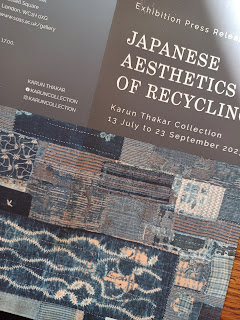This textile
exhibition, co-curated by Alice Kettle and Arnolfini, brings together the work
of 21 international artists and makers to ‘breathe life into materials’ and celebrate
the power of textiles to tell stories. Some narratives are personal others
explore wider global events but they all make connections between people and
places, memory and cultures. Public engagement is much to the fore and on the
day I visited dancers were moving among the audience, there was a live
commentary in the gallery and the audience was encouraged to join in, sit on
cushions and watch, or sew and draw. There were also workshops taking place on
the upper floors of the gallery all of which added to the lively ambience of
the exhibition.

There were so
many interesting exhibits that it is impossible to mention them so I’ll just
talk about a few of my favourites. The image here is of Ground by Alice
Kettle, a huge embroidery which is part of a series called Thread bearing
witness which incorporates images drawn by refugees in the Calais refugee
camps reflecting on stories of migration.
Esna Su’s
series of vessels The Burden II ‘My trousseau’ (image at the top) captivated
me, initially because of its lace-like quality and also its theme of textile as
part of a bride’s trousseau. Each vessel is tied like a fabric bag and includes
a small crochet doily or piece of lace (detail above), suggesting the bundle of
clothes and domestic fabrics a refugee or bride might carry with them to a new
home. These wearable sculptures that fit the shape of a human body are a
poignant reminder of the domestic upheaval faced by refugees.
I also found
Mounira Al Sohl’s work Mina El Shourouk ila Al Fahmah very moving. This Lebanese
artist uses a large, red, tent-like structure to bring together women’s stories
of struggle and loss with quotes from the women, embroidered images and song and
in this way uses storytelling to bring their memories to life.
A series of
pieces by Anya Paintsil also covered interesting themes relating to her Welsh
and Ghanaian heritage. In particular Cwympo ni’n dau, wel dyna I chi dric
(We both fall over that’s the trick) a title taken from a Welsh nursery
rhyme. This work depicts Rhiannon, a character from Welsh mythology falsely
accused of murdering and eating her newborn son who was sentenced to carry
strangers on her back for 7 years. Here the artist links that story to the themes
of burden and blame that are often place on women in society.
Celia Pym’s series
of Mended paper bags were also an interesting development of her mending
and repair series of darned clothes. She produced the bags during the Covid
pandemic as a response to the amount of packaging building up in her home. I
also enjoyed seeing the stitched cubes of Richard McVetis with their tiny black
stitches measuring time. Olga de Amaral’s Viento II also reflects on
time with its incorporation of Japanese paper and gold leaf.

Ifeoma U
Anyaeji also considers materials in her installation, Ezuhu ezu [In
(complete)] produced as part of a residency at Arnolfini. She uses discarded
plastic bottles and bags and by transforming them, using a hair braiding
technique from her homeland in Nigeria, asks us to consider the value we place
on discarded objects. As you can tell, I thoroughly enjoyed the exhibition and
would encourage you to visit if you are in the Bristol area as I’ve only
covered a few of the exhibits here. It runs until 1 October and the Arnolfini also
has an excellent bookshop and café!


















































